Origin of Our Solar System
Solar System: where I am?
You can find me in one of the four outer spiral arms of Milky Way which is known as Orion's arm.
I am 27,000 light-years away from the center of Milky Way. It took years to complete one revolution around the center in my orbit.
 |
| Solar system |
How I formed?
I formed nearly 4.5 billion years ago, from a dense cloud of interstellar gas and dust. The cloud collapsed possibly due to shock waves of a nearby exploding star called Supernova. When this dust cloud collapsed, it formed a solar nebula—a spinning, swirling disk of material. At the center, gravity pulled more and more material in. Eventually, the pressure in the core was so great that hydrogen atoms began to combine and form helium, releasing a tremendous amount of energy. With that, our Sun was born, and it eventually amassed more than 99 percent of the available matter.
Matter farther out in the disk was also clumping together. These clumps smashed into one another, forming larger and larger objects. Some of them grew big enough for their gravity to shape them into spheres, becoming planets, dwarf planets, and large moons. In other cases, planets did not form: the asteroid belt is made of bits and pieces of the early solar system that could never quite come together into a planet. Other smaller leftover pieces became asteroids, comets, meteoroids, and small, irregular moons.
Structure
The order and arrangement of the planets and other bodies in our solar system is due to the way the solar system formed. Nearest the Sun, only rocky material could withstand the heat when the solar system was young. For this reason, the first four planets—Mercury, Venus, Earth, and Mars—are terrestrial planets. They're small with solid, rocky surfaces.
Alright guys, thank you for reading my blog and give your suggestions in the comments below and feel free to subscribe to my blog or follow it.







2 Comments
great content
ReplyDeleteThank you for your valuable feedback
Delete